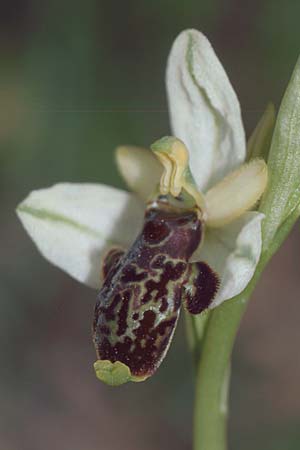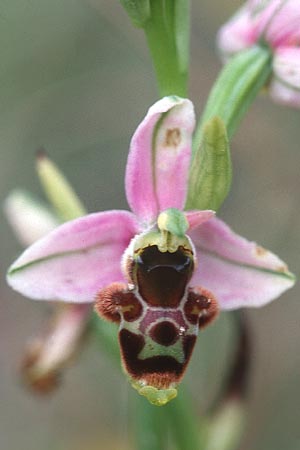 |
 |
 |
 |
 |
 Orchids with History
Orchids with History

|

Ophrys philippei, F Siou Blanc 18.5.04

Ophrys philippei, F Belgentier 10.5.02

Ophrys philippei, F Belgentier 10.5.02
|
| Ophrys philippei | | |

In 1859 the French botanist Charles GRENIER from Besancon described a small flowered and
relative late flowering Ophrys similar to scolopax as Ophrys philippi.
Thus he honoured the director of the botanical garden of the Imperial Marine in Saint Mandrier
near Toulon, Mathieu-Yves PHILIPPE, who had sent many plants from the environs of Toulon to GRENIER.
As site of the new orchid he indicated 'Montrieux',
which is located about 25 km north of the port of Toulon in a rather rough mountainous region. |
 |
|
During the following decades Ophrys philippi fell into oblivion. At least since E.G.Camus
(Iconographie (1929): 355)
botanists of later generations assumed, that the brown discoloured old herbarium specimens showed
a hybrid between Ophrys scolopax and one of the orchids of the Ophrys sphegodes group,
which are occurring in the Provence. |
 |
|
In 2000 Pierre DELFORGE tried to prove in Natural.belges 81 (Orchid. 13): 111-144
that GRENIER's Ophrys philippi is identical with the very small flowering
Ophrys, which had first been found in Western France and which is in flower in Juli.
Jean-Michel MATHE and Frédéric MELKI described it in 1994 first
invalidly as Ophrys aestivalis in L'Orchidophile 25 (112): 120-126,
and few months later with the valid name Ophrys santonica in
'L'Orchidophile' 25 (113): 158-159. Today plants from more eastern located mountains of Southern France,
which are earlier in flower, are counted to this species, too. |
 |

Ophrys santonica
F Mansle 4.7.98
More images |
|

Ophrys santonica
F St.Paul-en-Foret
18.5.02
|
|
In May 2000 at a site near Belgentier Pierre Michel BLAIS, the engaged orchid kartographer of the Provence,
discovered another small flowered Ophrys similar to scolopax
with remarkably dissolved speculum on the labellum, which was still unknown to him.
His and his friends' investigations during the next months proved that this was the real
Ophrys philippi of GRENIER, and the hypothesis of DELFORGE as mentioned above thereby an error. |
 |
|
In the rectangle of only about 3 x 7 km, in which Ophrys philippei has been found so far,
BLAIS indicates now 21 sites with all together 240 plants. It is the plateau of Siou Blanc,
as well as its Eastern and Northern flanks. On the Northern flank of Siou Blanc there is
the monastery 'Chartreuse de Montrieux le Jeune'. To his extensive web site
Orchidées de Provence BLAIS added the
'Dossier Ophrys philippi'
in 2001, in which he is e.g. showing the old herbarium specimens from the century before last. |
 |
Still today there is disagreement on the way of writing the name of this long neglected orchid:
While Pierre DELFORGE was using the grammatically correct name Ophrys philippei, the
International Plant Names Index,
which is maintained at the botanical gardens of Kew near London,
as well as
BLAIS and some other authors prefer to write Ophrys philippi as GRENIER already did.
Remy SOUCHE in his work 'Les Orchidées sauvages de France' from 2004 uses a third way to write
the orchid's name: Ophrys philippii.
|
| Contents |
Background photo: F Belgentier 10.5.02 |
10.9.05 |
Copyright: Use of the images and texts only with author's written permission.
|
 Orchids with History
Orchids with History





